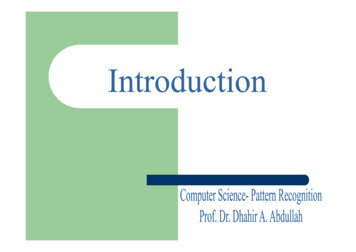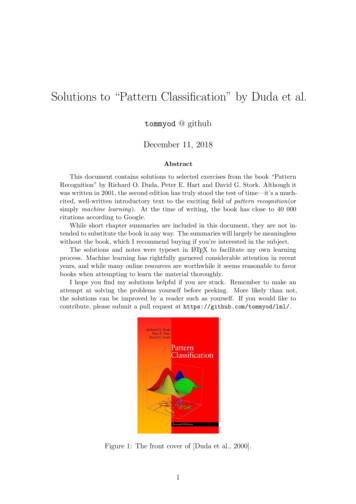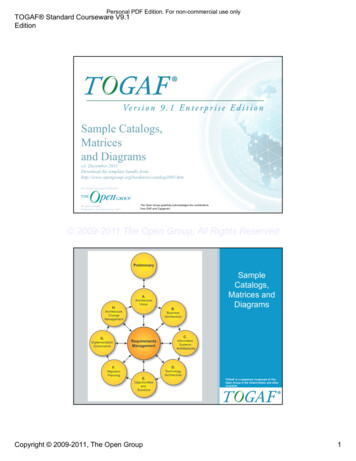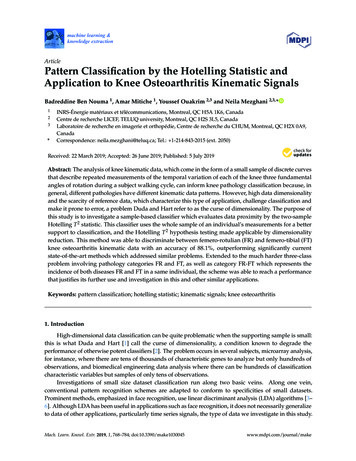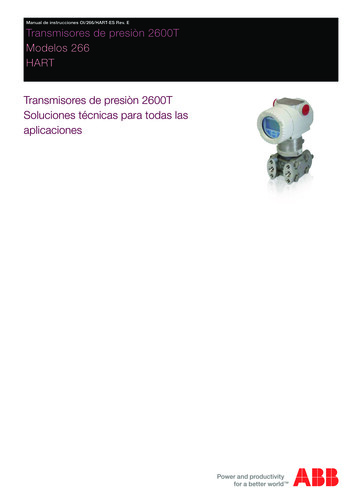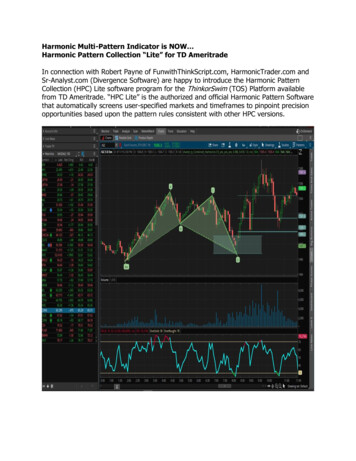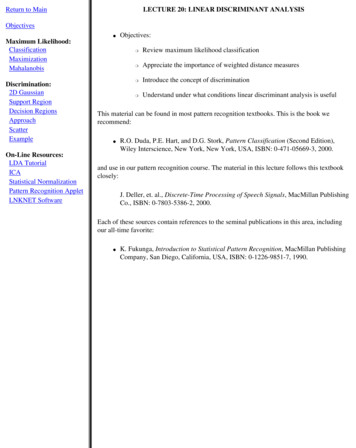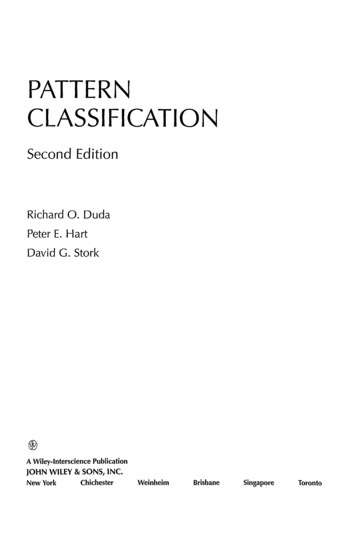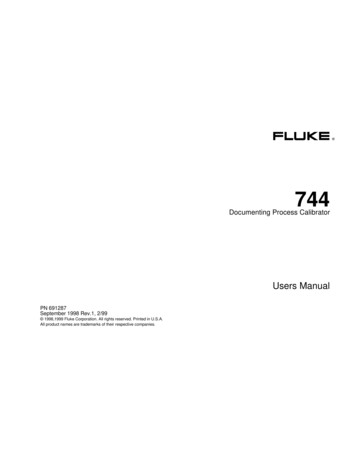
Transcription
Duda hart pattern classification diagram pdf download full
Contents 1 Introduction 1.1 Machine Perception . . . . . . . . . . . . . 1.2 An Example . . . . . . . . . . . . . . . . . . 1.2.1 Related fields . . . . . . . . . . . . . 1.3 The Sub-problems of Pattern Classification 1.3.1 Feature Extraction . . . . . . . . . . 1.3.2 Noise . . . . . . . . . . . . . . . . . 1.3.3 Overfitting . . . . . . . . . . . . . . 1.3.4 Model Selection . . . . . . . . . . . . 1.3.5 Prior Knowledge. . . . . . . . . . . 1.3.6 Missing Features . . . . . . . . . . . 1.3.7 Mereology . . . . . . . . . . . . . . . 1.3.8 Segmentation . . . . . . . . . . . . . 1.3.9 Context . . . . . . . . . . . . . . . . 1.3.10 Invariances . . . . . . . . . . . . . . 1.3.11 Evidence Pooling . . . . . . . . . . . 1.3.12 Costs and Risks . . . . . . . . . . . 1.3.13 Computational Complexity . . . . . 1.4 Learning and Adaptation . . . . . . . . . .1.4.1 Supervised Learning . . . . . . . . . 1.4.2 Unsupervised Learning . . . . . . . . 1.4.3 Reinforcement Learning . . . . . . . 1.5 Conclusion . . . . . . . . . . . . . . . . . . Summary by Chapters . . . . . . . . . . . . . . . Bibliographical and Historical Remarks . . . . . Bibliography . . . . . . . . . . . . . . . . . . . . Index . . . . . . . . . . . . . . . . . . . . . . . . 1 . . . . . . . . . . . . . . . . . . . . . . . . . . . . . . . . . . . . . . . . . . . . . . . . . . . . . . . . . . . . . . . . . . . . . . . . . . . . . . . . . . . . . . . . . . . . . . . . . . . . . . . . . . 3 3 3 11 11 11 12 12 12 12 13 13 13 14 14 15 15 16 16 16 17 17 17 17 19 19 22 2 CONTENTS Chapter 1 Introduction with which we recognize a face, understand spoken words, read handwritT hetenease characters, identify our car keys in our pocketby feel, and decide whether an apple is ripe by its smell belies the astoundingly complex processes that underlie these acts of pattern recognition. Pattern recognition — the act of taking in raw data and taking an action based on the “category” of the pattern — has been crucial for our survival, and over the past tens of millions of years we haveevolved highly sophisticated neural and cognitive systems for such tasks. 1.1 Machine Perception It is natural that we should seek to design and build machines that can recognize patterns. From automated speech recognition, fingerprint identification, optical character recognition, DNA sequence identification and much more, it is clear that reliable,accurate pattern recognition by machine would be immensely useful. Moreover, in solving the myriad problems required to build such systems, we gain deeper understanding and appreciation for pattern recognition systems in the natural world — most particularly in humans. For some applications, such as speech and visual recognition, our designefforts may in fact be influenced by knowledge of how these are solved in nature, both in the algorithms we employ and the design of special purpose hardware. 1.2 An Example To illustrate the complexity of some of the types of problems involved, let us consider the following imaginary and somewhat fanciful example. Suppose that a fish packingplant wants to automate the process of sorting incoming fish on a conveyor belt according to species. As a pilot project it is decided to try to separate sea bass from salmon using optical sensing. We set up a camera, take some sample images and begin to note some physical differences between the two types of fish — length, lightness, width, numberand shape of fins, position of the mouth, and so on — and these suggest features to explore for use in our classifier. We also notice noise or variations in the 3 4 CHAPTER 1. INTRODUCTION images — variations in lighting, position of the fish on the conveyor, even “static” due to the electronics of the camera itself. Given that there truly aredifferences between the population of sea bass and that model of salmon, we view them as having different models — different descriptions, which are typically mathematical in form. The overarching goal and approach in pattern classification is to hypothesize the class of these models, process the sensed data to eliminate noise (not due to themodels), and for any sensed pattern choose the model that corresponds best. Any techniques that further this aim should be in the conceptual toolbox of the designer of pattern recognition systems. Our prototype system to perform this very specific task might well have the form shown in Fig. 1.1. First the camera captures an image of the fish. Next,the camera’s presignals are preprocessed to simplify subsequent operations without loosing relevant processing information. In particular, we might use a segmentation operation in which the images of different fish are somehow isolated from one another and from the background. The segmentation information from a single fish is then sent to afeature extractor, whose purpose is to reduce the data by measuring certain “features” or “properties.” These features feature extraction (or, more precisely, the values of these features) are then passed to a classifier that evaluates the evidence presented and makes a final decision as to the species. The preprocessor might automatically adjust foraverage light level, or threshold the image to remove the background of the conveyor belt, and so forth. For the moment let us pass over how the images of the fish might be segmented and consider how the feature extractor and classifier might be designed. Suppose somebody at the fish plant tells us that a sea bass is generally longer than a salmon.These, then, give us our tentative models for the fish: sea bass have some typical length, and this is greater than that for salmon. Then length becomes an obvious feature, and we might attempt to classify the fish merely by seeing whether or not the length l of a fish exceeds some critical value l . To choose l we could obtain some design or trainingtraining samples of the different types of fish, (somehow) make length measurements, samples and inspect the results. Suppose that we do this, and obtain the histograms shown in Fig. 1.2. These disappointing histograms bear out the statement that sea bass are somewhat longer than salmon, on average, but it is clear that this single criterion isquite poor; no matter how we choose l , we cannot reliably separate sea bass from salmon by length alone. Discouraged, but undeterred by these unpromising results, we try another feature — the average lightness of the fish scales. Now we are very careful to eliminate variations in illumination, since they can only obscure the models and corruptour new classifier. The resulting histograms, shown in Fig. 1.3, are much more satisfactory — the classes are much better separated. So far we have tacitly assumed that the consequences of our actions are equally costly: deciding the fish was a sea bass when in fact it was a salmon was just as cost undesirable as the converse. Such a symmetry in thecost is often, but not invariably the case. For instance, as a fish packing company we may know that our customers easily accept occasional pieces of tasty salmon in their cans labeled “sea bass,” but they object vigorously if a piece of sea bass appears in their cans labeled “salmon.” If we want to stay in business, we should adjust our decisionboundary to avoid antagonizing our customers, even if it means that more salmon makes its way into the cans of sea bass. In this case, then, we should move our decision boundary x to smaller values of lightness, thereby reducing the number of sea bass that are classified as salmon (Fig. 1.3). The more our customers object to getting sea bass withtheir 1.2. AN EXAMPLE 5 Figure 1.1: The objects to be classified are first sensed by a transducer (camera), whose signals are preprocessed, then the features extracted and finally the classification emitted (here either “salmon” or “sea bass”). Although the information flow is often chosen to be from the source to the classifier (“bottom-up”), somesystems employ “top-down” flow as well, in which earlier levels of processing can be altered based on the tentative or preliminary response in later levels (gray arrows). Yet others combine two or more stages into a unified step, such as simultaneous segmentation and feature extraction. salmon — i.e., the more costly this type of error — the lower weshould set the decision threshold x in Fig. 1.3. Such considerations suggest that there is an overall single cost associated with our decision, and our true task is to make a decision rule (i.e., set a decision boundary) so as to minimize such a cost. This is the central task of decision theory of which pattern classification is perhaps the most importantsubfield. Even if we know the costs associated with our decisions and choose the optimal decision boundary x , we may be dissatisfied with the resulting performance. Our first impulse might be to seek yet a different feature on which to separate the fish. Let us assume, though, that no other single visual feature yields better performance than thatbased on lightness. To improve recognition, then, we must resort to the use decision theory 6 CHAPTER 1. INTRODUCTION salmon sea bass Count 22 20 18 16 12 10 8 6 4 2 0 Length 5 10 15 l* 20 25 Figure 1.2: Histograms for the length feature for the two categories. No single threshold value l (decision boundary) will serve to unambiguouslydiscriminate between the two categories; using length alone, we will have some errors. The value l marked will lead to the smallest number of errors, on average. Count 14 salmon sea bass 12 10 8 6 4 2 0 2 4 x* 6 Lightness 8 10 Figure 1.3: Histograms for the lightness feature for the two categories. No single threshold value x (decision boundary)will serve to unambiguously discriminate between the two categories; using lightness alone, we will have some errors. The value x marked will lead to the smallest number of errors, on average. 1.2. AN EXAMPLE Width 22 7 salmon sea bass 21 20 19 18 17 16 15 Lightness 14 2 4 6 8 10 Figure 1.4: The two features of lightness and width for sea bassand salmon. The dark line might serve as a decision boundary of our classifier. Overall classification error on the data shown is lower than if we use only one feature as in Fig. 1.3, but there will still be some errors. of more than one feature at a time. In our search for other features, we might try to capitalize on the observation that sea bass aretypically wider than salmon. Now we have two features for classifying fish — the lightness x1 and the width x2 . If we ignore how these features might be measured in practice, we realize that the feature extractor has thus reduced the image of each fish to a point or feature vector x in a two-dimensional feature space, where x x1 x2 . Our problemnow is to partition the feature space into two regions, where for all patterns in one region we will call the fish a sea bass, and all points in the other we call it a salmon. Suppose that we measure the feature vectors for our samples and obtain the scattering of points shown in Fig. 1.4. This plot suggests the following rule for separating the fish: Classifythe fish as sea bass if its feature vector falls above the decision boundary shown, and as salmon otherwise. This rule appears to do a good job of separating our samples and suggests that perhaps incorporating yet more features would be desirable. Besides the lightness and width of the fish, we might include some shape parameter, such as the vertexangle of the dorsal fin, or the placement of the eyes (as expressed as a proportion of the mouth-to-tail distance), and so on. How do we know beforehand which of these features will work best? Some features might be redundant: for instance if the eye color of all fish correlated perfectly with width, then classification performance need not beimproved if we also include eye color as a feature. Even if the difficulty or computational cost in attaining more features is of no concern, might we ever have too many features? Suppose that other features are too expensive or expensive to measure, or provide little improvement (or possibly even degrade the performance) in the approach describedabove, and that we are forced to make our decision based on the two features in Fig. 1.4. If our models were extremely complicated, our classifier would have a decision boundary more complex than the simple straight line. In that case all the decision boundary 8 CHAPTER 1. INTRODUCTION Width 22 salmon sea bass 21 20 19 ? 18 17 16 15Lightness 14 2 4 6 8 10 Figure 1.5: Overly complex models for the fish will lead to decision boundaries that are complicated. While such a decision may lead to perfect classification of our training samples, it would lead to poor performance on future patterns. The novel test point marked ? is evidently most likely a salmon, whereas the complexdecision boundary shown leads it to be misclassified as a sea bass. generalization training patterns would be separated perfectly, as shown in Fig. 1.5. With such a “solution,” though, our satisfaction would be premature because the central aim of designing a classifier is to suggest actions when presented with novel patterns, i.e., fish not yet seen.This is the issue of generalization. It is unlikely that the complex decision boundary in Fig. 1.5 would provide good generalization, since it seems to be “tuned” to the particular training samples, rather than some underlying characteristics or true model of all the sea bass and salmon that will have to be separated. Naturally, one approach would be toget more training samples for obtaining a better estimate of the true underlying characteristics, for instance the probability distributions of the categories. In most pattern recognition problems, however, the amount of such data we can obtain easily is often quite limited. Even with a vast amount of training data in a continuous feature space though,if we followed the approach in Fig. 1.5 our classifier would give a horrendously complicated decision boundary — one that would be unlikely to do well on novel patterns. Rather, then, we might seek to “simplify” the recognizer, motivated by a belief that the underlying models will not require a decision boundary that is as complex as that in Fig. 1.5.Indeed, we might be satisfied with the slightly poorer performance on the training samples if it means that our classifier will have better performance on novel patterns. But if designing a very complex recognizer is unlikely to give good generalization, precisely how should we quantify and favor simpler classifiers? How would our systemautomatically determine that the simple curve in Fig. 1.6 is preferable to the manifestly simpler straight line in Fig. 1.4 or the complicated boundary in Fig. 1.5? Assuming that we somehow manage to optimize this tradeoff, can we then predict how well our system will generalize to new patterns? These are some of the central problems in statisticalpattern recognition. For the same incoming patterns, we might need to use a drastically different cost The philosophical underpinnings of this approach derive from William of Occam (1284-1347?), who advocated favoring simpler explanations over those that are needlessly complicated — Entia non sunt multiplicanda praeter necessitatem (“Entitiesare not to be multiplied without necessity”). Decisions based on overly complex models often lead to lower accuracy of the classifier. 1.2. AN EXAMPLE Width 22 9 salmon sea bass 21 20 19 18 17 16 15 Lightness 14 2 4 6 8 10 Figure 1.6: The decision boundary shown might represent the optimal tradeoff between performance on the training set andsimplicity of classifier. function, and this will lead to different actions altogether. We might, for instance, wish instead to separate the fish based on their sex — all females (of either species) from all males if we wish to sell roe. Alternatively, we might wish to cull the damaged fish (to prepare separately for cat food), and so on. Different decision tasksmay require features and yield boundaries quite different from those useful for our original categorization problem. This makes it quite clear that our decisions are fundamentally task or cost specific, and that creating a single general purpose artificial pattern recognition device — i.e., one capable of acting accurately based on a wide variety of tasks— is a profoundly difficult challenge. This, too, should give us added appreciation of the ability of humans to switch rapidly and fluidly between pattern recognition tasks. Since classification is, at base, the task of recovering the model that generated the patterns, different classification techniques are useful depending on the type of candidate modelsthemselves. In statistical pattern recognition we focus on the statistical properties of the patterns (generally expressed in probability densities), and this will command most of our attention in this book. Here the model for a pattern may be a single specific set of features, though the actual pattern sensed has been corrupted by some form of randomnoise. Occasionally it is claimed that neural pattern recognition (or neural network pattern classification) should be considered its own discipline, but despite its somewhat different intellectual pedigree, we will consider it a close descendant of statistical pattern recognition, for reasons that will become clear. If instead the model consists of some setof crisp logical rules, then we employ the methods of syntactic pattern recognition, where rules or grammars describe our decision. For example we might wish to classify an English sentence as grammatical or not, and here statistical descriptions (word frequencies, word correlations, etc.) are inapapropriate. It was necessary in our fish example tochoose our features carefully, and hence achieve a representation (as in Fig. 1.6) that enabled reasonably successful pattern classification. A central aspect in virtually every pattern recognition problem is that of achieving such a “good” representation, one in which the structural relationships among the components is simply and naturally revealed,and one in which the true (unknown) model of the patterns can be expressed. In some cases patterns should be represented as vectors of real-valued numbers, in others ordered lists of attributes, in yet others descriptions of parts and their relations, and so forth. We seek a represen- 10 CHAPTER 1. INTRODUCTION tation in which the patterns thatlead to the same action are somehow “close” to one another, yet “far” from those that demand a different action. The extent to which we create or learn a proper representation and how we quantify near and far apart will determine the success of our pattern classifier. A number of additional characteristics are desirable for the representation. Wemight wish to favor a small number of features, which might lead to simpler decision regions, and a classifier easier to train. We might also wish to have features that are robust, i.e., relatively insensitive to noise or other errors. In practical applications we may need the classifier to act quickly, or use few electronic components, memory or processingsteps. analysis by synthesis A central technique, when we have insufficient training data, is to incorporate knowledge of the problem domain. Indeed the less the training data the more important is such knowledge, for instance how the patterns themselves were produced. One method that takes this notion to its logical extreme is that of analysis bysynthesis, where in the ideal case one has a model of how each pattern is generated. Consider speech recognition. Amidst the manifest acoustic variability among the possible “dee”s that might be uttered by different people, one thing they have in common is that they were all produced by lowering the jaw slightly, opening the mouth, placing thetongue tip against the roof of the mouth after a certain delay, and so on. We might assume that “all” the acoustic variation is due to the happenstance of whether the talker is male or female, old or young, with different overall pitches, and so forth. At some deep level, such a “physiological” model (or so-called “motor” model) for production of theutterances is appropriate, and different (say) from that for “doo” and indeed all other utterances. If this underlying model of production can be determined from the sound (and that is a very big if ), then we can classify the utterance by how it was produced. That is to say, the production representation may be the “best” representation forclassification. Our pattern recognition systems should then analyze (and hence classify) the input pattern based on how one would have to synthesize that pattern. The trick is, of course, to recover the generating parameters from the sensed pattern. Consider the difficulty in making a recognizer of all types of chairs — standard office chair,contemporary living room chair, beanbag chair, and so forth — based on an image. Given the astounding variety in the number of legs, material, shape, and so on, we might despair of ever finding a representation that reveals the unity within the class of chair. Perhaps the only such unifying aspect of chairs is functional: a chair is a stable artifact thatsupports a human sitter, including back support. Thus we might try to deduce such functional properties from the image, and the property “can support a human sitter” is very indirectly related to the orientation of the larger surfaces, and would need to be answered in the affirmative even for a beanbag chair. Of course, this requires some reasoningabout the properties and naturally touches upon computer vision rather than pattern recognition proper. Without going to such extremes, many real world pattern recognition systems seek to incorporate at least some knowledge about the method of production of the patterns or their functional use in order to insure a good representation, though ofcourse the goal of the representation is classification, not reproduction. For instance, in optical character recognition (OCR) one might confidently assume that handwritten characters are written as a sequence of strokes, and first try to recover a stroke representation from the sensed image, and then deduce the character from the identified strokes.1.3. THE SUB-PROBLEMS OF PATTERN CLASSIFICATION 1.2.1 11 Related fields Pattern classification differs from classical statistical hypothesis testing, wherein the sensed data are used to decide whether or not to reject a null hypothesis in favor of some alternative hypothesis. Roughly speaking, if the probability of obtaining the data given somenull hypothesis falls below a “significance” threshold, we reject the null hypothesis in favor of the alternative. For typical values of this criterion, there is a strong bias or predilection in favor of the null hypothesis; even though the alternate hypothesis may be more probable, we might not be able to reject the null hypothesis. Hypothesis testing is oftenused to determine whether a drug is effective, where the null hypothesis is that it has no effect. Hypothesis testing might be used to determine whether the fish on the conveyor belt belong to a single class (the null hypothesis) or from two classes (the alternative). In contrast, given some data, pattern classification seeks to find the most probablehypothesis from a set of hypotheses — “this fish is probably a salmon.” Pattern classification differs, too, from image processing. In image processing, the input is an image and the output is an image. Image processing steps often include rotation, contrast enhancement, and other transformations which preserve all the original information. Featureextraction, such as finding the peaks and valleys of the intensity, lose information (but hopefully preserve everything relevant to the task at hand.) As just described, feature extraction takes in a pattern and produces feature values. The number of features is virtually always chosen to be fewer than the total necessary to describe the complete target ofinterest, and this leads to a loss in information. In acts of associative memory, the system takes in a pattern and emits another pattern which is representative of a general group of patterns. It thus reduces the information somewhat, but rarely to the extent that pattern classification does. In short, because of the crucial role of a decision in patternrecognition information, it is fundamentally an information reduction process. The classification step represents an even more radical loss of information, reducing the original several thousand bits representing all the color of each of several thousand pixels down to just a few bits representing the chosen category (a single bit in our fish example.) 1.3The Sub-problems of Pattern Classification We have alluded to some of the issues in pattern classification and we now turn to a more explicit list of them. In practice, these typically require the bulk of the research and development effort. Many are domain or problem specific, and their solution will depend upon the knowledge and insights of thedesigner. Nevertheless, a few are of sufficient generality, difficulty, and interest that they warrant explicit consideration. 1.3.1 Feature Extraction The conceptual boundary between feature extraction and classification proper is somewhat arbitrary: an ideal feature extractor would yield a representation that makes the job of the classifier trivial;conversely, an omnipotent classifier would not need the help of a sophisticated feature extractor. The distinction is forced upon us for practical, rather than theoretical reasons. Generally speaking, the task of feature extraction is much more problem and domain dependent than is classification proper, and thus requires knowledge of the domain. Agood feature extractor for sorting fish would image processing associative memory 12 CHAPTER 1. INTRODUCTION surely be of little use for identifying fingerprints, or classifying photomicrographs of blood cells. How do we know which features are most promising? Are there ways to automatically learn which features are best for the classifier?How many shall we use? 1.3.2 Noise The lighting of the fish may vary, there could be shadows cast by neighboring equipment, the conveyor belt might shake — all reducing the reliability of the feature values actually measured. We define noise very general terms: any property of the sensed pattern due not to the true underlying model but instead torandomness in the world or the sensors. All non-trivial decision and pattern recognition problems involve noise in some form. In some cases it is due to the transduction in the signal and we may consign to our preprocessor the role of cleaning up the signal, as for instance visual noise in our video camera viewing the fish. An important problem isknowing somehow whether the variation in some signal is noise or instead to complex underlying models of the fish. How then can we use this information to improve our classifier? 1.3.3 Overfitting In going from Fig 1.4 to Fig. 1.5 in our fish classification problem, we were, implicitly, using a more complex model of sea bass and of salmon. That is, wewere adjusting the complexity of our classifier. While an overly complex model may allow perfect classification of the training samples, it is unlikely to give good classification of novel patterns — a situation known as overfitting. One of the most important areas of research in statistical pattern classification is determining how to adjust the complexityof the model — not so simple that it cannot explain the differences between the categories, yet not so complex as to give poor classification on novel patterns. Are there principled methods for finding the best (intermediate) complexity for a classifier? 1.3.4 Model Selection We might have been unsatisfied with the performance of our fish classifier inFigs. 1.4 & 1.5, and thus jumped to an entirely different class of model, for instance one based on some function of the number and position of the fins, the color of the eyes, the weight, shape of the mouth, and so on. How do we know when a hypothesized model differs significantly from the true model underlying our patterns, and thus a new model isneeded? In short, how are we to know to reject a class of models and try another one? Are we as designers reduced to random and tedious trial and error in model selection, never really knowing whether we can expect improved performance? Or might there be principled methods for knowing when to jettison one class of models and invoke another?Can we automate the process? 1.3.5 Prior Knowledge In one limited sense, we have already seen how prior knowledge — about the lightness of the different fish categories helped in the design of a classifier by suggesting a promising feature. Incorporating prior knowledge can be far more subtle and difficult. In some applications the knowledgeultimately derives from information about the production of the patterns, as we saw in analysis-by-synthesis. In others the knowledge may be about the form of the underlying categories, or specific attributes of the patterns, such as the fact that a face has two eyes, one nose, and so on. 1.3. THE SUB-PROBLEMS OF PATTERN CLASSIFICATION 1.3.613 Missing Features Suppose that during classification, the value of one of the features cannot be determined, for example the width of the fish because of occlusion by another fish (i.e., the other fish is in the way). How should the categorizer compensate? Since our two-feature recognizer never had a single-variable threshold value x determined inanticipation of the possible absence of a feature (cf., Fig. 1.3), how shall it make the best decision using only the feature present?
Duda hart pattern classification diagram pdf download full. . accurate pattern recognition by machine would be immensely useful. Moreover, in solving the myriad problems required to build such systems, we gain deeper understanding and appreciation for pattern recognition systems in the natural world — most particularly in humans. For some .
